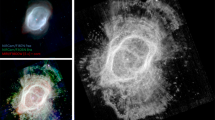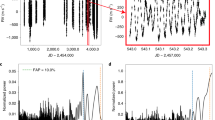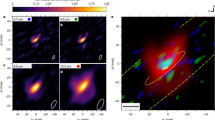Abstract
When viewed in optical starlight scattered by dust, the nearly edge-on debris disk surrounding the A5V star β Pictoris (distance 19.3 pc; ref. 1) extends farther than 1,450 au from the star2. Its large-scale complexity has been well characterized, but the detailed structure of the disk's central ∼200-au region has remained elusive. This region is of special interest, because planets may have formed there during the star's 10–20-million-year lifetime3,4, perhaps resulting in both the observed tilt of 4.6 degrees relative to the large-scale main disk5,6 and the partial clearing of the innermost dust7,8,9. A peculiarity of the central disk (also possibly related to the presence of planets) is the asymmetry in the brightness of the ‘wings’9,10, in which the southwestern wing is brighter and more extended at 12 µm than the northeastern wing. Here we present thermal infrared images of the central disk that imply that the brightness asymmetry results from the presence of a bright clump composed of particles that may differ in size from dust elsewhere in the disk. We suggest that this clump results from the collisional grinding of resonantly trapped planetesimals or the cataclysmic break-up of a planetesimal.
This is a preview of subscription content, access via your institution
Access options
Subscribe to this journal
Receive 51 print issues and online access
$199.00 per year
only $3.90 per issue
Buy this article
- Purchase on Springer Link
- Instant access to full article PDF
Prices may be subject to local taxes which are calculated during checkout





Similar content being viewed by others
References
Crifo, F., Vidal-Madjar, A., Lallement, R., Ferlet, R. & Gerbaldi, M. β Pictoris revisited by Hipparcos. Star properties. Astron. Astrophys. 320, L29–L32 (1997)
Larwood, J. D. & Kalas, P. G. Close stellar encounters with planetesimal disks: the dynamics of asymmetry in the β Pictoris system. Mon. Not. R. Astron. Soc. 323, 402–416 (2001)
Barrado y Navascués, D., Stauffer, J. R., Song, I. & Caillault, J.-P. The age of Beta Pictoris. Astrophys. J. 520, L123–L126 (1999)
Zuckerman, B., Song, I., Bessell, M. S. & Webb, R. A. The β Pictoris moving group. Astrophys. J. 562, L87–L90 (2001)
Heap, S. et al. Space telescope imaging spectrograph coronagraphic observations of β Pictoris. Astrophys. J. 539, 435–444 (2000)
Mouillet, D., Larwood, J. D., Papaloizou, J. C. B. & Lagrange, A. M. A planet on an inclined orbit as an explanation of the warp in the β Pictoris disc. Mon. Not. R. Astron. Soc. 292, 896–904 (1997)
Telesco, C. M., Becklin, E. E., Wolstencroft, R. D. & Decher, R. Resolution of the circumstellar disk of β Pictoris at 10 and 20 µm. Nature 335, 51–53 (1988)
Backman, D. E., Gillett, F. C. & Witteborn, F. C. Infrared observations and thermal models of the β Pictoris dust disk. Astrophys. J. 385, 670–679 (1992)
Lagage, P. O. & Pantin, E. Dust depletion in the inner disk of Beta Pictoris as a possible indicator of planets. Nature 369, 628–630 (1994)
Pantin, E., Lagage, P. O. & Artymowicz, P. Mid-infrared images and models of the β Pictoris dust disk. Astron. Astrophys. 327, 1123–1136 (1997)
Weinberger, A. J., Becklin, E. E. & Zuckerman, B. The first spatially resolved mid-infrared spectroscopy of β Pictoris. Astrophys. J. 584, L33–L37 (2003)
Wahhaj, Z. et al. The inner rings of β Pictoris. Astrophys. J. 584, L27–L31 (2003)
Okamoto, Y. K. et al. An extrasolar planetary system revealed by planetesimal belts in β Pictoris. Nature 431, 660–662 (2004)
Li, A. & Greenberg, J. M. A comet dust model for the β Pictoris disk. Astron. Astrophys. 331, 291–313 (1998)
Ozernoy, L. M., Gorkavyi, N. N., Mather, J. C. & Taidakova, T. A. Signatures of exosolar planets in dust disks. Astrophys. J. 537, L147–L151 (2000)
Sicardy, B., Beaugé, C., Ferraz-Mello, S., Lazzaro, D. & Roques, F. Capture of grains into resonances through Poynting-Robertson drag. Celest. Mech. Dyn. Astron. 57, 373–390 (1993)
Dermott, S. F., Jayaraman, S., Xu, Y. L., Gustafson, B. & Liou, J. C. A circumsolar ring of asteroidal dust in resonant lock with the Earth. Nature 369, 719–723 (1994)
Wyatt, M. C. et al. How observations of circumstellar disk asymmetries can reveal hidden planets: pericenter glow and its application to the HR4796 disk. Astrophys. J. 527, 918–944 (1999)
Wyatt, M. C. Resonant trapping of planetesimals by planet migration: debris disk clumps and Vega's similarity to the Solar System. Astrophys. J. 598, 1321–1340 (2003)
Lagrange-Henri, A. M., Vidal-Madjar, A. & Ferlet, R. The β Pictoris circumstellar disk. VI. Evidence for material falling on to the star. Astron. Astrophys. 190, 275–282 (1988)
Beust, H., Vidal-Madjar, A., Ferlat, R. & Lagrange-Henri, A. M. Cometary-like bodies in the protoplanetary disk around β Pictoris. Astrophys. Space Sci. 212, 147–157 (1994)
Wyatt, M. C. & Dent, W. R. F. Collisional processes in extrasolar planetesimal discs—dust clumps in Fomalhaut's debris disc. Mon. Not. R. Astron. Soc. 334, 589–607 (2002)
Brandeker, A., Liseau, R., Olofsson, G. & Fridlund, M. The spatial structure of the β Pictoris gas disk. Astron. Astrophys. 413, 681–691 (2004)
Dominik, C. & Decin, G. Age dependence of the Vega phenomenon: theory. Astrophys. J. 598, 626–635 (2003)
Hartmann, W. K. & Davis, D. R. Satellite-sized planetesimals and lunar origin. Icarus 24, 504–515 (1975)
Dermott, S. F., Kehoe, T. J. J., Durda, D. D., Grogan, K. & Nesvorný, D. in Asteroids, Comets, and Meteors 2002 (ed. Warmbein, B.) ESA SP-500, 319–322 (Publications Division, Noordwijk, 2002)
Kenyon, S. J. & Bromley, B. C. Detecting the dusty debris of terrestrial planet formation. Astrophys. J. 602, L133–L136 (2004)
Van Paradijs, J., Telesco, C. M., Kouveliotou, C. & Fishman, G. J. 10 micron detection of the hard x-ray transient GRO J0422+32: free-free emission from an x-ray-driven accretion disk wind? Astrophys. J. 429, L19–L23 (1994)
Acknowledgements
We dedicate this paper to the memory of our colleague F. Gillett, infrared astronomy pioneer and co-discoverer of circumstellar debris disks. We thank K. Hanna, J. Julian and R. Piña for contributions to the success of T-ReCS; F. Varosi for assistance with data reduction; the Gemini Observatory staff in Chile, particularly M.-C. Hainaut-Rouelle, for technical assistance; and D. Simons of Gemini Observatory for support. This paper is based on observations (programme number GS-2003B-14) obtained at the Gemini Observatory, which is operated by the Association of Universities for Research in Astronomy, Inc., under a cooperative agreement with the NSF on behalf of the Gemini partnership: the National Science Foundation (United States), the Particle Physics and Astronomy Research Council (United Kingdom), the National Research Council (Canada), CONICYT (Chile), the Australian Research Council (Australia), CNPq (Brazil) and CONICET (Argentina). This research was funded in part by an NSF grant to C.M.T.
Author information
Authors and Affiliations
Corresponding author
Ethics declarations
Competing interests
The authors declare that they have no competing financial interests.
Rights and permissions
About this article
Cite this article
Telesco, C., Fisher, R., Wyatt, M. et al. Mid-infrared images of β Pictoris and the possible role of planetesimal collisions in the central disk. Nature 433, 133–136 (2005). https://doi.org/10.1038/nature03255
Received:
Accepted:
Issue Date:
DOI: https://doi.org/10.1038/nature03255
This article is cited by
-
Evidence for an additional planet in the β Pictoris system
Nature Astronomy (2019)
-
Insights into Planet Formation from Debris Disks
Space Science Reviews (2016)
-
Five steps in the evolution from protoplanetary to debris disk
Astrophysics and Space Science (2015)
-
Two families of exocomets in the β Pictoris system
Nature (2014)
-
Formation and evolution of planetary systems: the impact of high-angular resolution optical techniques
The Astronomy and Astrophysics Review (2010)
Comments
By submitting a comment you agree to abide by our Terms and Community Guidelines. If you find something abusive or that does not comply with our terms or guidelines please flag it as inappropriate.



